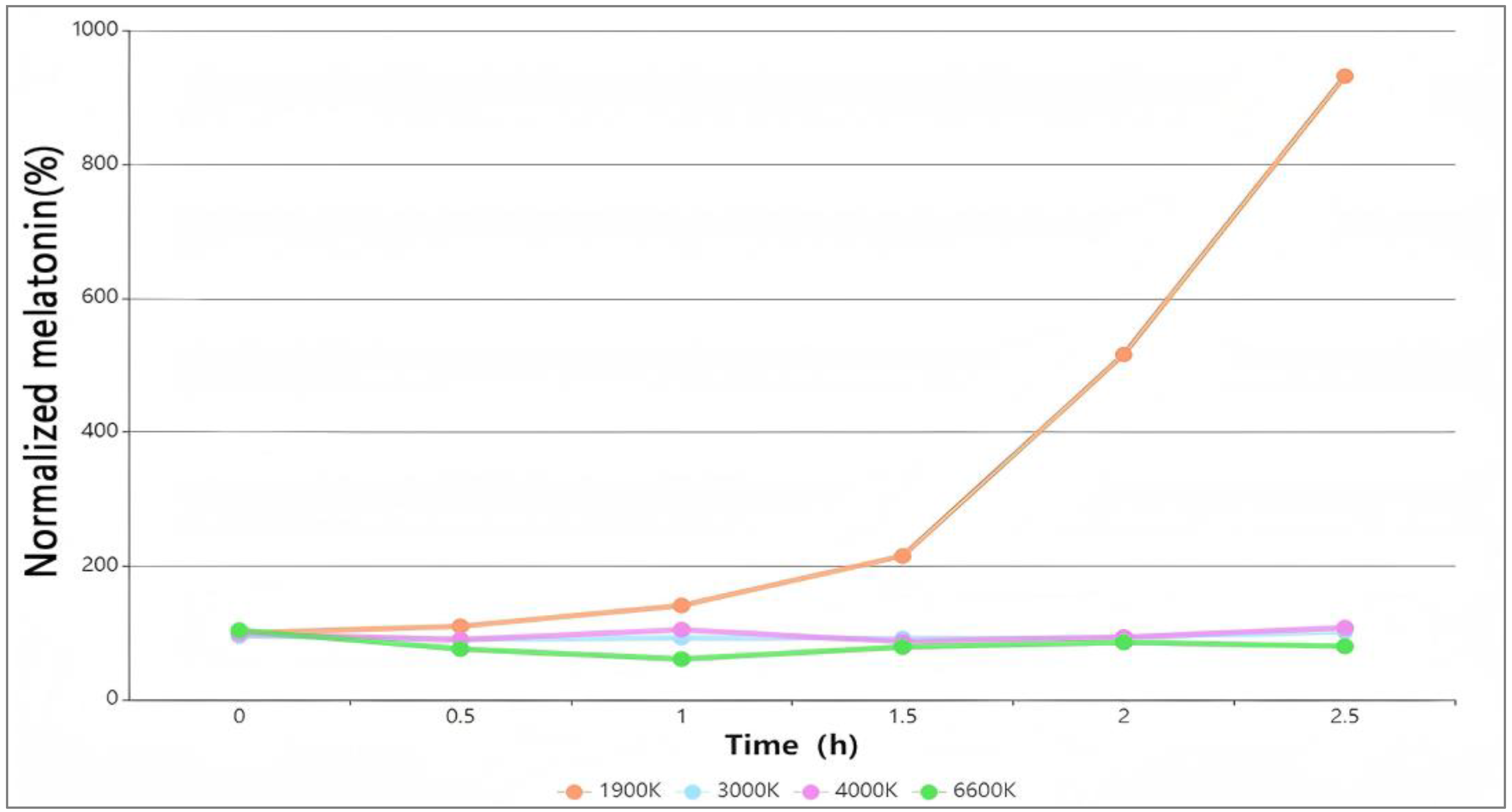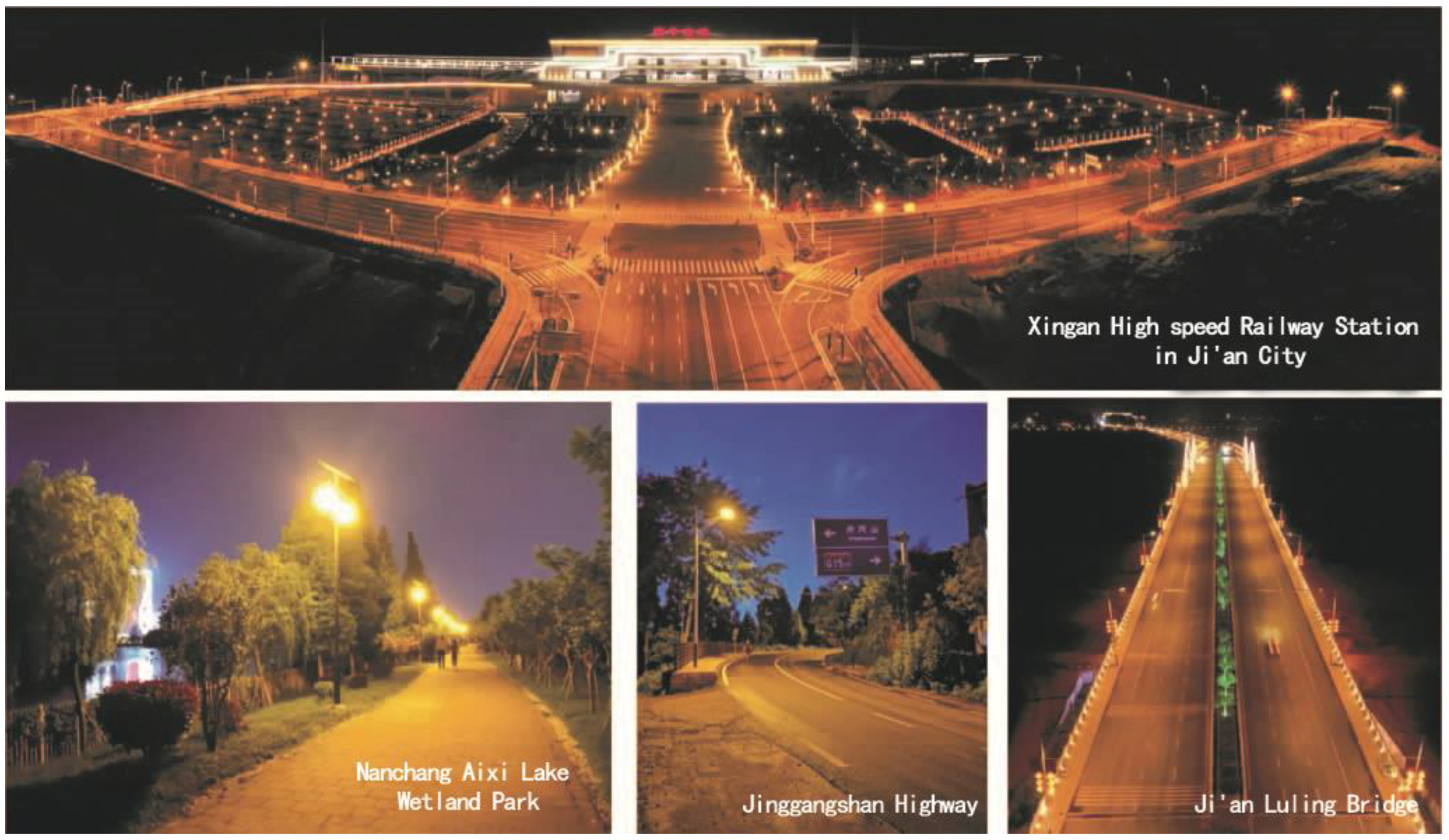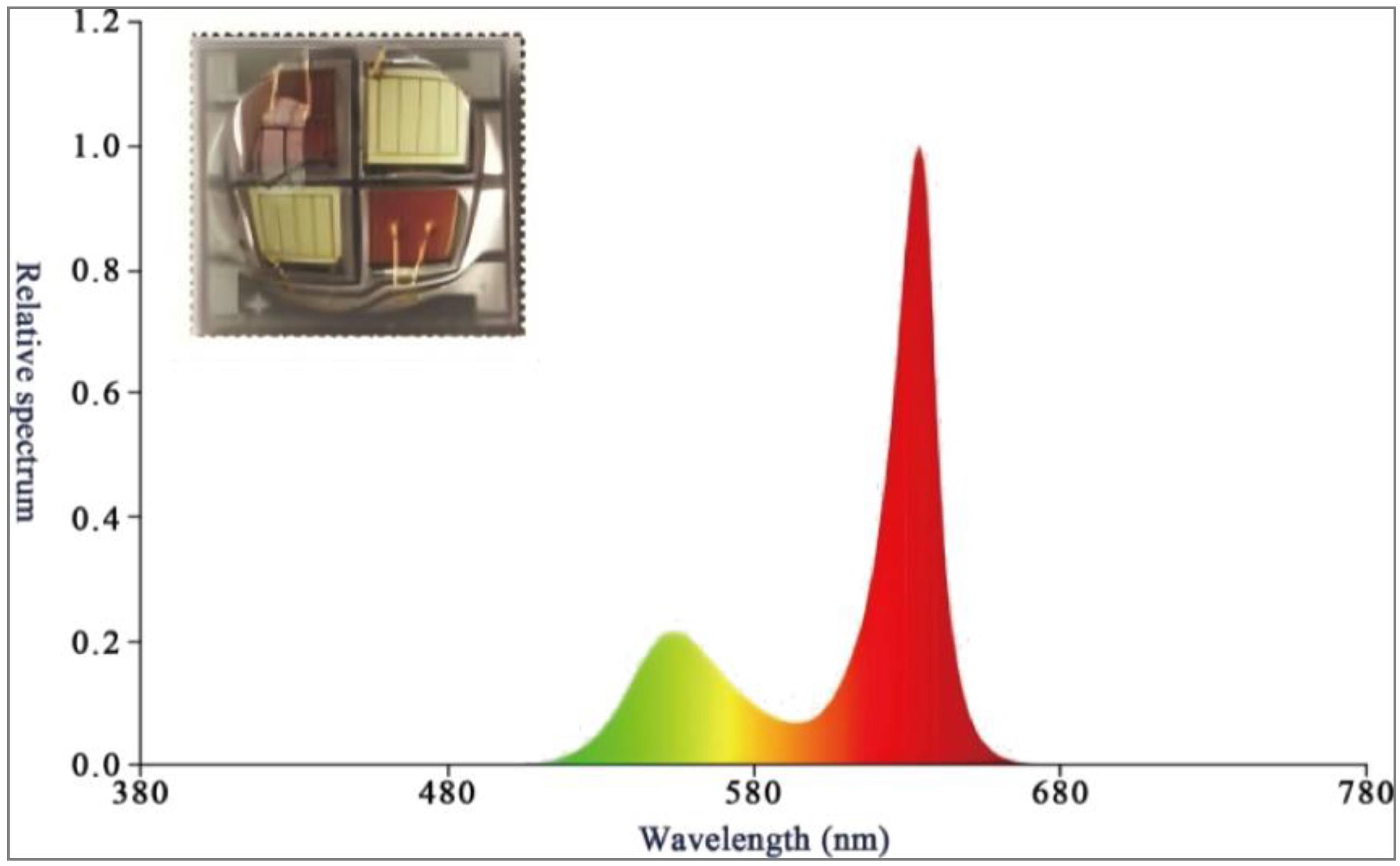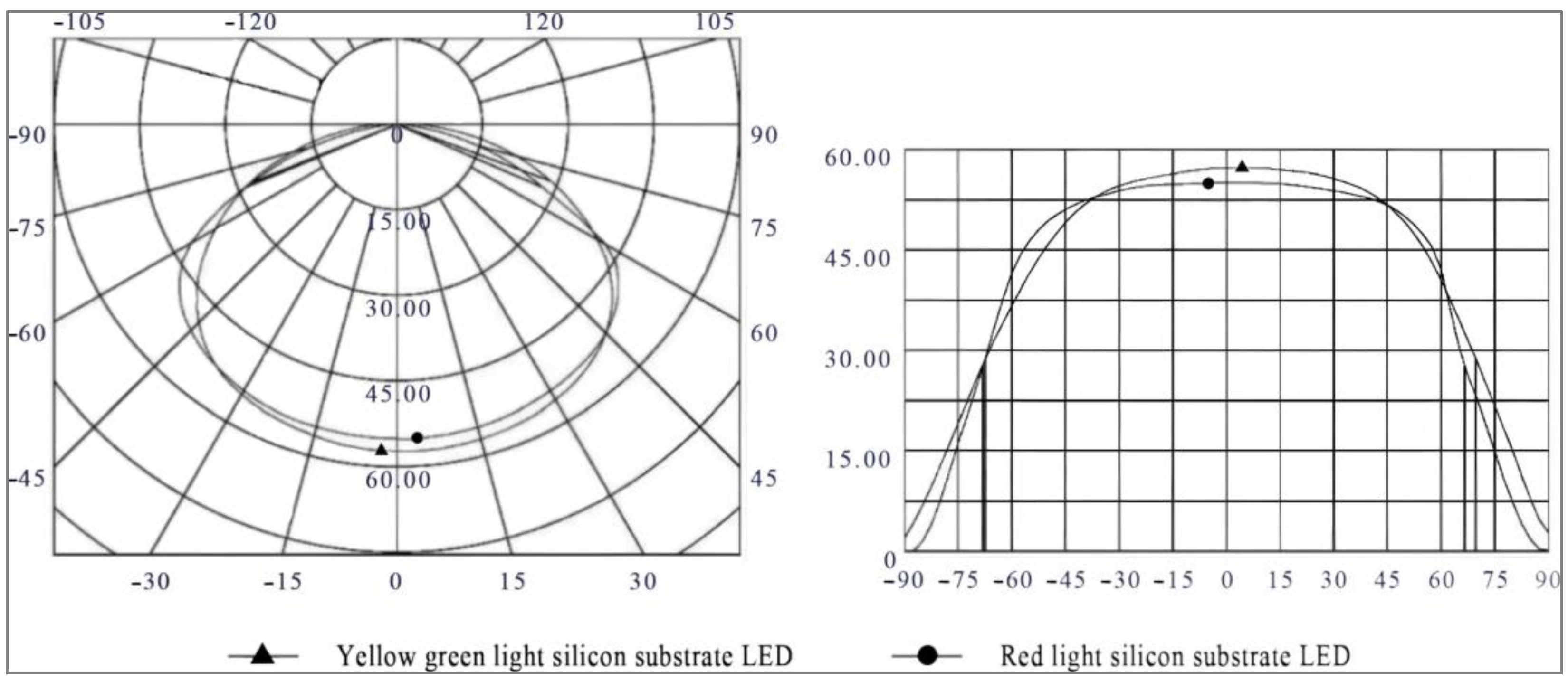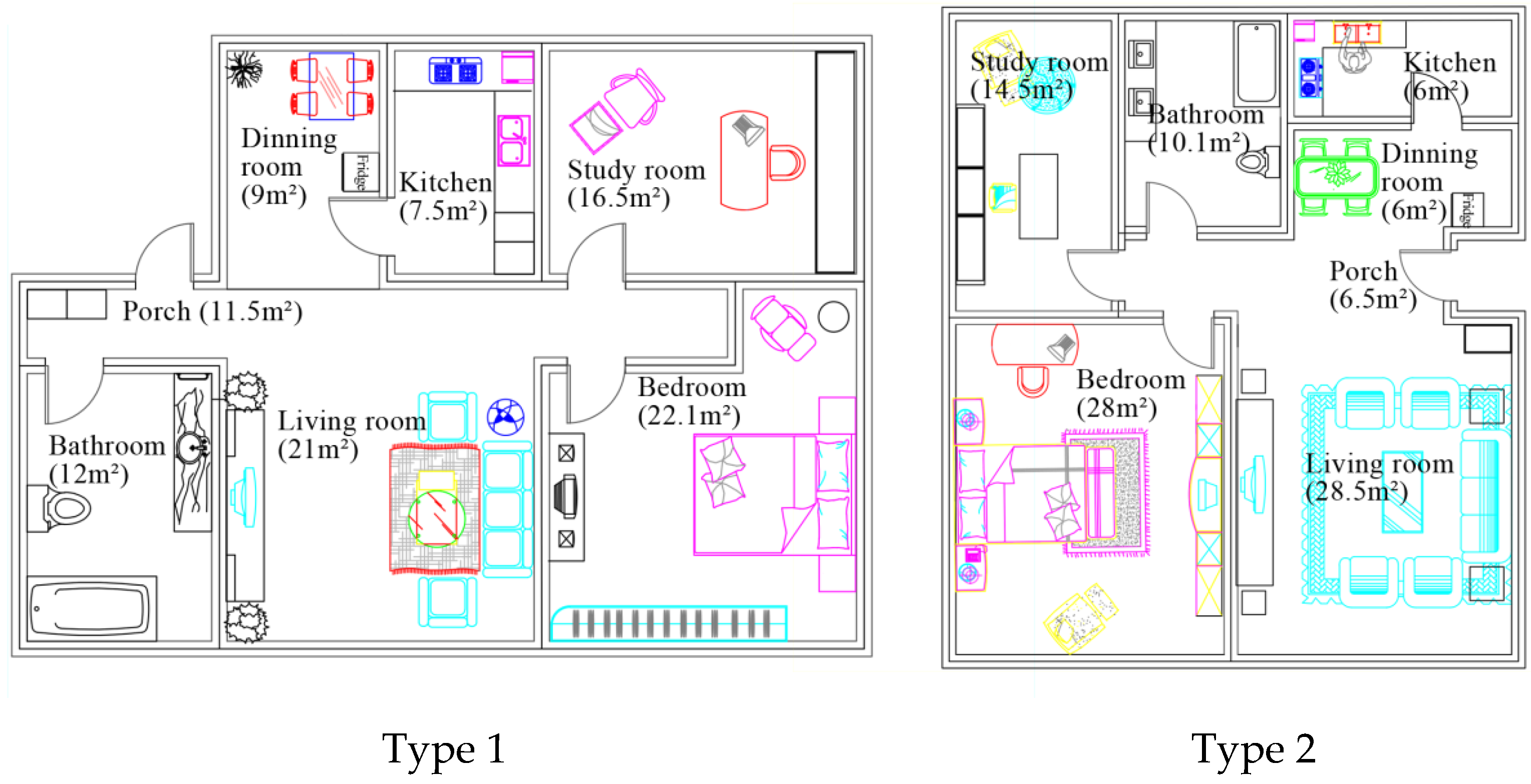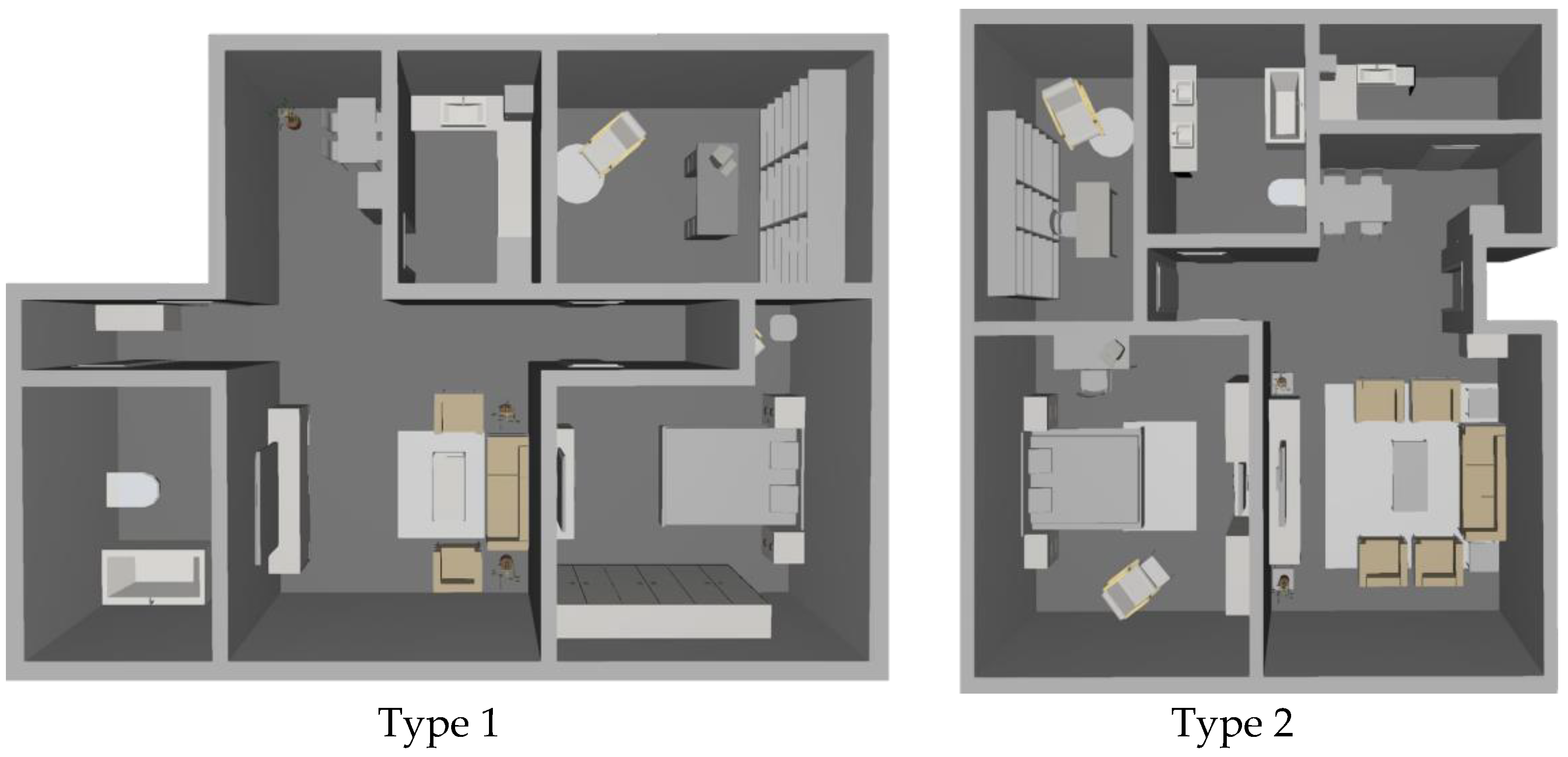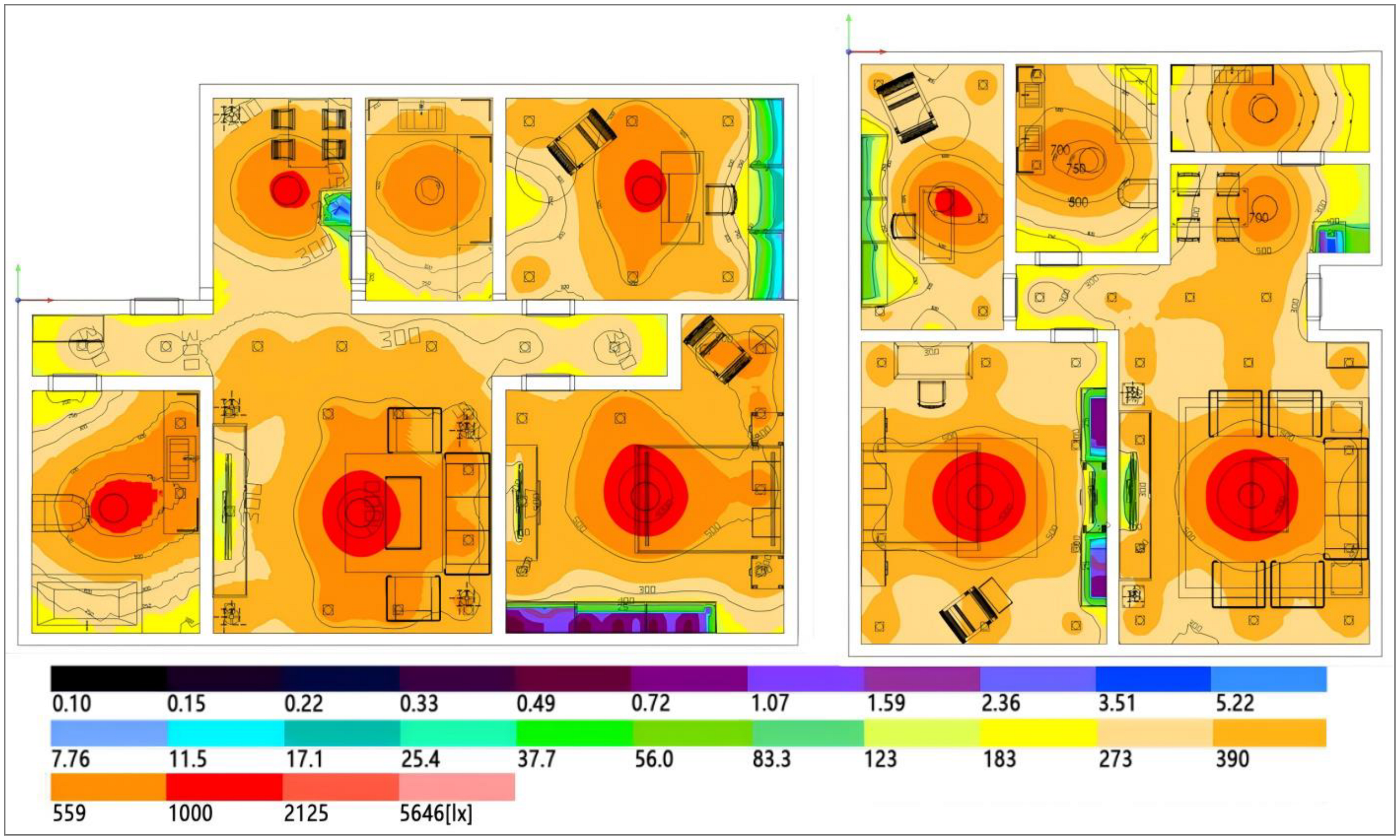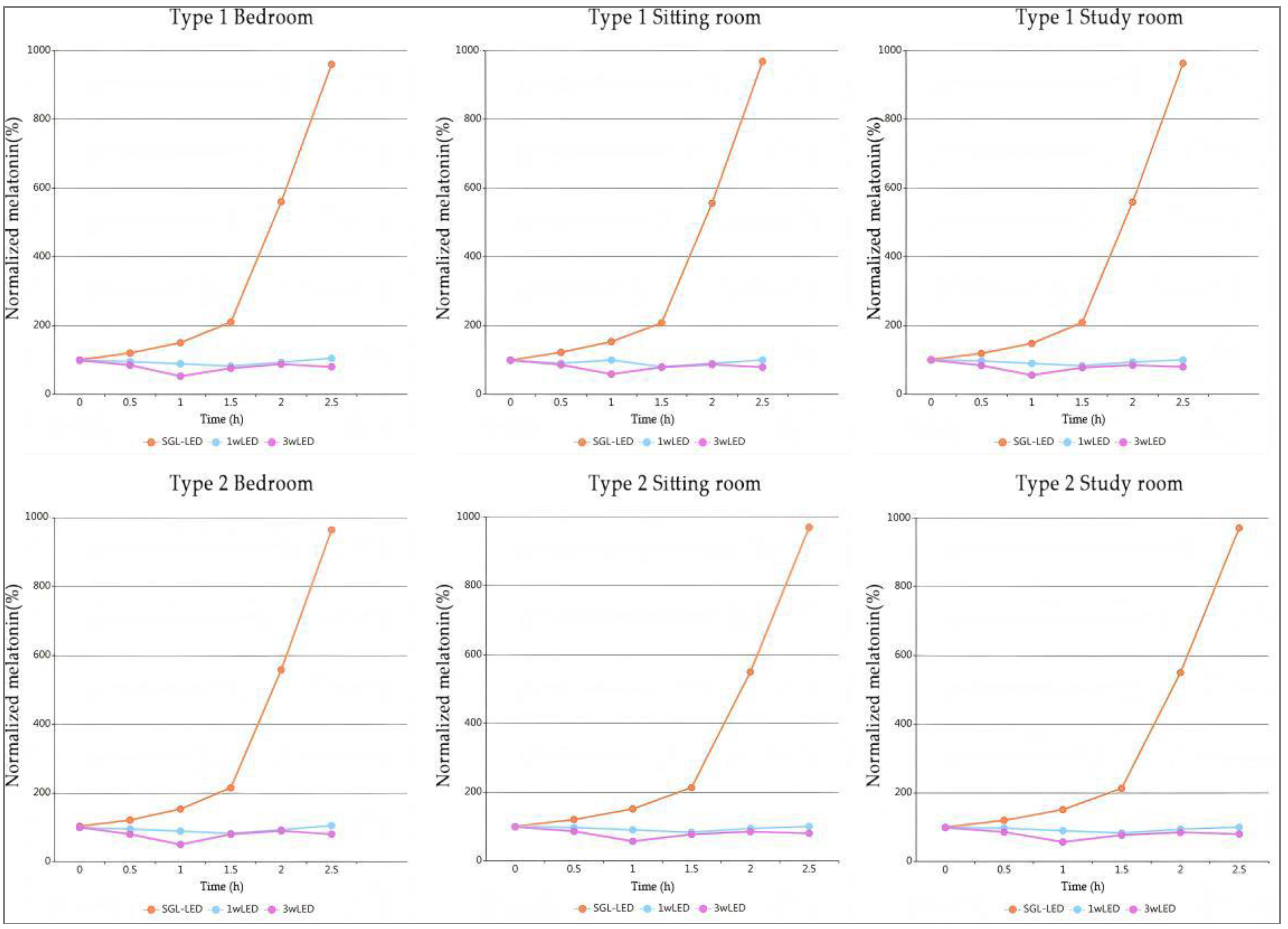1. Introduction
Indoor lighting quality has been confirmed to be closely related to the regulation of the human circadian rhythm [
1]. The design of indoor lighting systems should minimize interference with the normal circadian rhythms of plants and animals [
2]. As a new type of lighting technology, LED offers significant advantages in terms of environmental protection, energy efficiency, lifespan, and safety [
3]. Traditional LED lighting technology uses blue light LEDs to excite a yellow phosphor on the surface to synthesize white light. Blue light, with wavelengths between 440 nm and 470 nm, has relatively high energy [
4]. Many experimental studies have shown that artificial light with high color temperature can interfere with the normal biological laws of human beings [
5]. Prolonged exposure to this light environment can cause visual fatigue, damage the eye structure, lead to retinal blue light damage, suppress melatonin secretion, and cause adverse effects such as insomnia [
6]. Additionally, self-illuminating electronic devices such as computers and smartphones also emit blue light, which further suppresses melatonin secretion [
7]. A low color temperature light source can create a warm, comfortable, and relaxed atmosphere, which can promote human melatonin secretion, thus contributing to sleep and promoting visual health [
8]. Melatonin plays a critical role in treating insomnia, anti-aging, treating depression, promoting bone cell proliferation and differentiation [
9], regulating immunity, and preventing external bacterial damage [
10]. The suppression of melatonin may be unique to its production process [
11]. As the issue of blue light in visual health becomes increasingly recognized as a significant health concern, researchers have made various attempts to address the blue light problem, such as blue light-blocking glasses [
12], blue light screen protectors [
13], and blue light-blocking lamps, among other products. These innovations have helped to some extent reduce the visual damage caused by blue light.
The silicon substrate golden light LED technology, which is based on a zero-blue-light source, provides a new direction for lighting design in the field of home health, guiding the development of the blue-light-free healthy lighting trend in indoor lighting. The silicon substrate golden light LED (Jiangxi Jinhuangguang Lighting Co., Ltd., Shangrao, China) is a new lighting technology developed by Jiang Fengyi’s team. This technology fundamentally avoids the “blue-light hazard” issue inherent in LED phosphor-based lighting technology, eliminating energy loss and heat dissipation issues caused by phosphor light conversion. It is a proprietary technology that offers higher theoretical luminous efficacy, greater reliability, and higher biological safety levels [
14,
15]. Unlike traditional LED phosphor-based lighting technology, which uses blue light LEDs to excite phosphors, the silicon substrate golden light LED uses high-efficiency yellow and red LEDs to synthesize light. Many studies show that high correlated color temperature (3000–6600 K) artificial light can interfere with human biological rhythms, potentially leading to circadian rhythm disturbances (OR = 1.78, 95%CI 1.2–2.6), dry eye syndrome (incidence increased by 37%), and other pathological conditions [
16]. The silicon substrate golden light LED, however, is a low correlated color temperature (1900 ± 100 K), blue-light-free, and phosphor-free health light source. Lin et al. conducted an experiment to test the photonic efficacy of silicon substrate golden light LED, comparing the 1900 K silicon substrate golden light LED with three other light sources (3000 K, 4000 K, and 6600 K) for melatonin level testing, and the experimental results are shown in
Figure 1 [
17]. Over a 2.5 h period, saliva samples were collected every 30 min to monitor melatonin levels. The results showed that, under the 1900 K silicon substrate golden light LED, melatonin secretion was initially low for the first 1.5 h, but after 1.5 h of exposure, a significant amount of melatonin was secreted, as shown in
Figure 1. The silicon substrate golden light LED has a positive effect on promoting the secretion of melatonin and glutamate [
18], not only stimulating melatonin secretion but also alleviating eye dryness or redness. Long-term exposure also promotes wound healing and hair regeneration. This demonstrates that, in the field of indoor health lighting, silicon substrate golden light LED has a significant advantage over traditional LEDs, aligning better with the development trend of human visual health [
19].
The silicon substrate golden light LED source appears in urban road lighting applications in the form of street lamps, as shown in
Figure 2. Compared to conventional LED sources, the silicon substrate golden light LED has the following advantages: (1) The correlated color temperature of the silicon substrate golden light LED is around 2000 K, and its light spectrum does not contain blue or violet light with wavelengths shorter than 500 nm. The warm tone of the light helps reduce light pollution while contributing to ecological protection; (2) The silicon substrate golden light LED does not use phosphor, inherently avoiding the light degradation issue caused by phosphor in white LEDs, making the lamp performance more stable; (3) This light source combines yellow and red long-wavelength light, which has better penetration ability in low-visibility weather and is more easily reflected by the road surface, thereby increasing road brightness and improving the safety of road travel [
20]. In conclusion, the silicon substrate golden light LED can enhance road safety and improve the environmental, urban, and biological friendliness of road lighting [
21].
In the field of indoor lighting, the silicon substrate golden light LED is primarily used to create a healthy lighting environment by leveraging its blue-light-free characteristics, aligning with the trend of indoor home health lighting [
22]. Published research reports have indicated that the silicon substrate golden light LED can provide various benefits to the human body, especially for populations such as mothers and infants, children, and the elderly [
17]. As shown in
Figure 3, lighting products such as blue-light-free mother-and-baby lamps, bedside lamps, and ambient lighting have all achieved positive economic and social benefits [
23].
It is important to note that a blue-light-free home lighting environment cannot be created by just one type of lamp; rather, it requires a combination of various lamps to form a lighting system that collectively creates a blue-light-free atmosphere. When designing a zero-blue-light environment, it is necessary to comprehensively consider the impact of color temperature on the indoor environment, and achieve the best lighting effect through a combination of various luminaire [
24]. This lighting system includes primary light sources (ceiling lights, downlights) and auxiliary light sources (bedside lamps, table lamps, nightlights, etc.). Based on this, this study uses silicon substrate golden light LED as the home lighting source, and, on the basis of meeting the lighting demands of two indoor types, employs DIALux Evo (Version 9.2, DIAL GmbH, Lüdenscheid, Germany) lighting simulation software to simulate the indoor lighting environment. In this context, this study compares melatonin exposure experiments for two indoor types, aiming to provide a blue-light-free healthy lighting environment and a sustainable solution for home health lighting design.
2. Materials and Methods
2.1. National Lighting Standards
The “Building Lighting Design Standard” GB/T50034-2024 [
25], issued by the Ministry of Housing and Urban–Rural Development of China, is a national standard that defines the basic principles, technical requirements, and methods for building lighting design. It is applicable to the lighting design of various building projects. The standard will be implemented starting from 1 August 2024. In this study, the experimental data are based on the “Building Lighting Design Standard”, including parameters such as illuminance values, surface reflection ratios, and building parameters [
26].
Table 1 presents the illuminance standards for various areas in residential buildings as specified in the standard (minimum illuminance value), clearly outlining the lighting requirements for different rooms based on age groups, including non-elderly (children, youth, and middle-aged individuals) and elderly individuals.
2.2. Photonic Performance of Silicon Substrate Golden Light LED
The silicon substrate golden light LED (Jiangxi Jinhuangguang Lighting Co., Ltd., Shangrao, China) used in this study is model CHL-5050AIN (5 V-200 K) [
27]. The model lamp bead consists of two yellow and green light silicon substrate LEDs and two red light silicon substrate LEDs. Its photonic performance is shown in
Table 2, the light spectrum of the LED is presented in
Figure 4, and the light distribution curve is shown in
Figure 5. The single conventional power of the lamp beads used in this paper is as follows: power: 1.78 W, correlated color temperature: 1900 K, luminous flux: 190 lm, luminous efficacy: 105 lm/W, input current: 400 mA, voltage: 4.45 V, and color rendering index (Ra): 76 [
28].
2.3. DIALux Evo Software Simulation Setup
Light makes both natural and artificial environments more tangible [
29]. The quality of lighting directly affects people’s visual experiences [
30]. DIALux Evo is one of the lighting simulation computer software tools [
31], capable of simulating and analyzing the performance of lighting systems in specific geographical locations and object environments, with results presented in digital, graphical, and visual forms [
32]. DIALux Evo allows for the simulation and calculation of lighting in different scenarios, where lighting parameters can be adjusted, such as material selection, luminaire placement, luminous flux, light distribution curve, light color, and light blur [
33]. In lighting calculations, factors such as illuminance, uniformity, and glare values can be quickly and accurately calculated within the software, and other elements such as available space settings, building materials, ambiance creation, and focus concentration can also be designed and simulated. In the lighting simulation experiment, various parameters of the luminaires can be adjusted based on actual needs, enabling rapid comparison of different schemes and scenarios within the same project, significantly saving time and making the process of modifying and optimizing indoor lighting solutions more focused and targeted [
34]. There may be discrepancies between the simulation results and the measurements obtained with professional optical measurement instruments because the parameters in the software are ideal values, which may differ from the real environment. However, the evaluation of the simulation results shows that DIALux Evo provides a more scientific and convincing basis for lighting simulation design [
35].
Based on this, this study uses DIALux Evo, with a grid precision of 0.1 m × 0.1 m and a ray-tracing count ≥ 10
6 times, with material reflectance calibrated according to the ASTM E1477-19 standard [
36], to verify the lighting efficiency of the silicon substrate golden light LED. The experiment selects two common home types and establishes models in DIALux Evo, setting the lighting source as the silicon substrate golden light LED. It should be noted that in this simulation experiment, the Ra value of the silicon substrate golden light LED lamp bead was 76. However, after adding hardware such as lampshades and reflectors to form the luminaire product, its Ra index reached the standard of 80. At the same time, the luminaire and building parameters are strictly set according to the standard values of the Building Lighting Design Standard GB/T50034-2024. After obtaining the simulated illuminance maps and corresponding illuminance values (maximum and minimum) for each area through the simulation experiment, the illuminance values are compared with the standards (minimum illuminance values) specified in the “Building Lighting Design Standard” to determine whether the silicon substrate golden light LED meets the home lighting requirements in each lighting area. This study further selected five commonly known LED brands on the market to compare their optical performance with that of the silicon-based golden light LED (SGL-LED). Since the commercially available standard LEDs do not match the exact power of the SGL-LED, which is 1.78 W, falling between 1 W and 3 W, 1 W and 3 W standard LEDs were selected for a light efficiency comparison with the SGL-LED [
24]. Considering that comparing 1 W and 3 W LEDs is conventional, and that increasing the power in the illuminance experiment can meet the indoor lighting requirements according to the lighting standards, we selected an SGL-LED with a power of 1.78 W, which falls within the range between 1 W and 3 W, making it a reference. Therefore, the experiment was designed to only include the illuminance experiment for the SGL-LED for comparative evaluation.
2.3.1. Indoor Space Layout Data Configuration
The structure of indoor spaces and the selection of luminaires are two critical factors that influence indoor lighting performance. In this simulation experiment, no windows are included in the 3D models of the selected buildings, and daylight factors are excluded from the light source setup to control the impact of external light on the experimental results. At the same time, the building model setup is based on real sample building types, and the data are referenced to the lighting standards for a realistic arrangement, ensuring that the experimental simulation data closely match actual conditions [
37].
- (1)
Type Data
The rationality of the indoor space structure not only affects the collection of natural light but also impacts the efficiency of indoor lighting [
38]. Types 1 and 2 (
Figure 6) are set based on actual home types, with different structures to facilitate the comparison of two sets of lighting simulation data. The aim is to verify the feasibility and scientific validity of a blue-light-free healthy lighting environment.
To ensure the rigor of the simulation experiment, the surface reflection ratios of the interior surfaces in both types were strictly controlled. The ceiling and wall surfaces were coated with white latex paint, which forms a durable and smooth surface. The floor material chosen is wear-resistant and slip-resistant ceramic tiles [
39]. According to the Building Design Standard, the surface reflection ratios for rooms used for long periods of time are specified, as shown in
Table 3. The building parameters for Types 1 and 2 are set as shown in
Table 4.
- (2)
Experimental Lighting Data
As one of the key factors influencing indoor lighting performance, the selection of lighting efficiency for luminaires is particularly important [
40]. In this study, the lighting data collection areas include the bedroom, sitting room, study, dining room, kitchen, bathroom, and porch, with each area using only primary light source luminaires. The power of the selected primary light source luminaires is set based on the lighting power density values for residential buildings, as specified in the Building Lighting Design Standard, as shown in
Table 5. The current values are used as the standard to set appropriate power parameters for each area [
41].
2.3.2. DIALux Evo Lighting Simulation Experiment Setup
- (1)
3D Scene Construction
This study uses the CAD floor plans (2024 version) of Types 1 and 2 to create 3D models in DIALux Evo software at a 1:1 scale, as shown in
Figure 7.
- (2)
Luminaire Parameter Setup
The power and luminous flux of luminaires are the main factors influencing their lighting performance [
42]. Power not only affects luminous flux but also reflects the energy consumption of the luminaires [
43]. In this study’s lighting simulation experiment, the power of the luminaires is set based on the lighting power density values for residential buildings and the applicable area power for other brand finished luminaires as references. According to the lighting power density values for residential buildings shown in
Table 5, the parameter settings should fall between the current value and the target value within the lighting power density range to be reasonable [
44].
For example, in the bedroom of Type 1, there are eight downlights with a power of 42.72 W, and the ceiling light has 38 silicon substrate golden light LED bulbs, with a total power of 67.64 W, giving a total power for the area of 110.36 W. The area is 22.1 m
2, so the lighting power density for this area is 110.36/22.1 ≈ 4.99, which is a reasonable lighting power density. Based on these conditions, the final power settings for the silicon substrate golden light LED ceiling lights and downlights in Types 1 and 2 are determined (
Table 6 and
Table 7).
- (3)
Luminaire Positioning Type
The lighting effect in a space is closely linked to the reasonable type of luminaires [
45]. For the simulation, the luminaire type was designed based on actual lighting arrangements, ensuring a reasonable distribution of ceiling lights and downlights to provide a more realistic lighting environment for Types 1 and 2. It is important to note that the luminaire positions in the experiment were determined based on the comprehensive opinions of multiple interior designers, lighting engineers, and lighting specialists. Additionally, the photonic performance characteristics of the silicon substrate golden light LED were considered in finalizing the luminaire positions, as shown in
Figure 8.
Based on this, the simulation parameters were run in DIALux Evo, modifying the power and luminous flux of the ceiling lights and downlights in each area according to the luminaire parameters for the two Types, as shown in
Table 6 and
Table 7. The goal was to ensure that the experimental data closely matched real-world conditions.
2.4. Energy Consumption Experiment Setup
This study selected five commonly available LED products from well-known brands on the market for a comparative optical performance analysis with the silicon substrate golden light LED. Since the ordinary LEDs available in the market do not have the same power as the silicon substrate golden light LED (1.78 W), this study chose 1 W and 3 W ordinary LEDs (
Table 8 and
Table 9) for comparison with the silicon substrate golden light LED to enhance the reliability of the energy consumption comparison experiment.
In the samples of 1 W and 3 W LEDs in
Table 8 and
Table 9, the LEDs with the highest luminous efficacy (lm/W) were selected, as shown in
Table 10. These selected sample LEDs were then compared with the silicon substrate golden light LED in the same environment, using the same luminous flux, to compare the required power (Power = area lighting flux/luminous flux per LED).
For example, in the bedroom of Type 1, with a building area of 22.10 m2, the required luminous flux for the ceiling light is 7220 lm, and the total luminous flux for the downlights is 4560 lm. The overall lighting for the area must meet the lighting standards specified in the Building Lighting Design Standard.
For the ceiling light, the silicon substrate golden light LED requires 67.64 W, the 1 W LED requires 81 W, and the 3 W LED requires 123 W.
For the downlights, the silicon substrate golden light LED requires 42.72 W, the 1 W LED requires 51 W, and the 3 W LED requires 78 W.
2.5. Melatonin Secretion Experiment Setup
To further study the relationship between silicon substrate golden light LED and melatonin, melatonin secretion levels need to be tested. The melatonin characteristic study experiment was conducted in a real lighting environment. Volunteers were exposed to both silicon substrate golden light LED and ordinary LED light sources. Saliva samples were collected from the volunteers at regular intervals, and the melatonin concentration in the saliva was detected using high-performance liquid chromatography (HPLC). After obtaining the experimental data, a comparison of melatonin secretion levels was made to demonstrate the effect of prolonged exposure to silicon substrate golden light LED on melatonin secretion in the human body.
Since people spend most of their time in bedrooms, sitting rooms, and study rooms in daily life, the experiment selected the bedroom, sitting room, and study room from Types 1 and 2 for the melatonin secretion experiment. A total of 15 healthy volunteers, aged 20 to 25 years, were recruited for the experiment. All volunteers were healthy, with no visual diseases or skin disorders. Informed consent was obtained from the volunteers before the experiment, and they were briefed on the experimental precautions. The experiment anonymized the volunteers’ melatonin secretion data and did not harm the volunteers or generate any commercial benefits. The 15 volunteers were divided into three groups, with 5 volunteers in each group. During the experiment, each group was assigned to one specific area (bedroom, sitting room, or study). Volunteers were allowed to carry out daily activities in the designated lighting areas, but the use of any device that could generate other light sources was prohibited. The experiment also included shading the doors and windows to prevent any external light from affecting the experimental light source.
The experiment lasted for 6 days, with daily sessions from 9:00 to 11:30 a.m., lasting 2.5 h. At the beginning of the experiment, an initial saliva sample was collected from each volunteer, and saliva samples were then collected every 30 min to monitor melatonin concentration levels in different time intervals. To ensure the authenticity and scientific integrity of the experiment, the same batch of 15 volunteers was used for the entire study. Volunteers were anonymized with numbers 1 to 15, and they were assigned to the bedroom (volunteers 1–5), sitting room (volunteers 6–10), and study (volunteers 11–15) based on a random draw. The experiments for the two types lasted 6 days, with one experimental group being tested each day. On alternating days, the volunteers within the same area were rotated to a different experimental sample area. After the first type experiment (days 1–3), the experiment was moved to the second type (days 4–6), as shown in
Table 11.
Given that each volunteer has different physical conditions, initial melatonin levels, and varying melatonin secretion levels over time, the data for each experiment were averaged from the five volunteers in the same area. The melatonin concentration data for each group of five volunteers were averaged (rounded to the nearest integer) to represent the overall melatonin secretion levels. After completing the melatonin secretion experiment for the silicon substrate golden light LED, the same experimental method was applied to the sample LEDs. This allowed for a comparison of melatonin secretion levels after exposure to different light sources and provided evidence to verify whether the silicon substrate golden light LED in home lighting promotes melatonin secretion more effectively than ordinary LEDs.
3. Results
3.1. Lighting Simulation Illuminance Results
Based on the illuminance maps generated by DIALux Evo, the lighting conditions in each area can be observed [
46]. In the illuminance maps, the greater the orange area, the higher the illuminance value, with CIELAB color space analysis showing that the orange areas correspond to illuminance ≥ 500 lx (R
2 = 0.97). On the other hand, the greener the area, the lower the illuminance value. The data in the illuminance table represent the range from the lowest to the highest illuminance values in each space. The illuminance simulation maps for Types 1 and 2 are shown in
Figure 9.
The illuminance simulation results for the functional areas of the two home types (99.6 m
2) using silicon substrate golden light LED are shown in
Table 12. The data indicate that, in Type 1, the illuminance range for key activity areas such as the bedroom, sitting room, and study is between 123 and 1000 lx, with the kitchen prep area (300–750 lx) and porch (183–390 lx) both exceeding the requirements set by the national standard (GB/T50034-2024). In Type 2, the lowest illuminance value in the bedroom and sitting room (56 lx) occurs in non-activity areas (such as the back of the wardrobe), while the illuminance on primary activity surfaces remains between 500 and 1000 lx. The effective lighting areas in the kitchen and dining room are 183–700 lx and 300–700 lx, respectively, meeting the standard values. These results show that the SGL-LED provides adequate and compliant lighting in both types, with low illuminance areas confined to non-functional corners, without affecting actual usage requirements.
3.2. Lighting Power Consumption Comparison Results
In this study, the power consumption comparison results for silicon substrate golden light LED in two different types are shown in
Table 13 and
Table 14. Compared to 1 W LED and 3 W LED light sources, the SGL-LED requires significantly lower power to meet the same luminous flux demand.
In Type 1, the lighting power for primary activity areas such as the bedroom, sitting room, and study using SGL-LED is 67.64, 60.52, and 49.84, respectively. In contrast, under the same luminous flux requirements, using 1 W LEDs and 3 W LEDs would require power consumptions of 81 W, 72 W, and 60 W, as well as 123 W, 108 W, and 90 W, respectively. Meanwhile, SGL-LEDs would need 38, 34, and 28 units. For 1 W LEDs and 3 W LEDs, the number of units required would be 81, 72, and 60, as well as 41, 36, and 30, respectively. This shows that the SGL-LED provides adequate lighting brightness while maintaining significantly lower power consumption than traditional 1 W and 3 W LED light sources.
In comparison to Type 2, the power required in the bedroom and sitting room using SGL-LED is 49.0 W and 49.0 W, respectively, whereas 1 W LED and 3 W LED require 103.4 W, 51.7 W, and 103.4 W, 51.7 W. Even under higher luminous flux conditions, the SGL-LED is still able to achieve the same lighting effect with lower power, demonstrating its significant energy efficiency advantage.
3.3. Melatonin Secretion Level Comparison Results
According to the melatonin secretion experiment data shown in
Table 15,
Table 16,
Table 17,
Table 18,
Table 19 and
Table 20, the melatonin secretion levels for silicon substrate golden light LED (SGL-LED) were significantly higher than those for 1 W LED and 3 W LED light sources in both types across different time periods. Specifically, after 2.5 h of exposure, the SGL-LED group exhibited a significant increase in melatonin secretion, with average secretion concentrations reaching (960 ± 15) pg/mL in the bedroom, sitting room, and study room. In contrast, the secretion concentrations for the 1 W LED and 3 W LED groups remained at lower levels, and even showed a negative growth in some time periods. These results indicate that the SGL-LED has a significant advantage in promoting melatonin secretion. It effectively supports the regulation of biological rhythms and contributes to improving sleep quality.
Figure 10 presents the results of the melatonin secretion experiment. The experimental results show that, under the illumination of the silicon substrate golden light LED, the melatonin secretion concentration exhibits a continuous upward trend, with the secretion rate significantly accelerating after 1.5 h of exposure. In contrast, under the illumination of 1 W LED and 3 W LED light sources, the melatonin secretion levels remain stable or at lower levels, indicating that these light sources were ineffective in promoting melatonin secretion.
4. Discussion
4.1. Illuminance Experiment Data Analysis
Based on the illuminance maps generated by DIALux Evo, the lighting conditions in each area can be observed. In the illuminance maps, the more orange areas present, the higher the illuminance values. On the other hand, the greener the areas, the lower the illuminance values. Notably, extremely low illuminance values are observed in both Type 1 and Type 2, particularly in areas such as the bookshelf, wardrobe, top of the refrigerator, and the back of the TV, as indicated in the type plan (
Figure 6). Since the reference surface for illuminance is at 0.75 m height and the height of the top of these areas exceeds this reference level, and the back of the TV receives no light exposure, these regions have low illuminance values, which are considered ineffective for this experiment [
47].
In Type 1, the illuminance values at the reference plane of the bedroom range from 123 to 1000 lx. From the illuminance map, it can be seen that the 123–273 lx range in the bedroom is limited to small areas on the sides of the wardrobe and the back of the TV. Based on the illuminance gradation values, the main activity area of the bedroom shows illuminance values between 500 and 1000 lx, which meets the general lighting requirement. In the sitting room, the reference plane illuminance values range from 123 to 1000 lx. The map shows that the 123–273 lx green area is located at the back of the TV, and this area is not considered a primary area. Based on the gradation values, the main working plane illuminance in the sitting room falls between 300 and 1000 lx, with the main activity area illuminance between 559 and 1000 lx, which satisfies the general lighting requirement. In the study, the reference plane illuminance values range from 183 to 1000 lx. The 183–273 lx range is concentrated in the bookshelf area and non-working areas, which does not affect the lighting in the activity area and constitutes a small part. Based on the gradation values, the main activity area illuminance is between 500 and 1000 lx, which meets the general lighting requirement for all groups, including the need for writing and reading. In the bathroom, the main activity area illuminance ranges from 183 to 1000 lx, with most areas showing values between 250 and 1000 lx. The illuminance values in the washing and makeup areas are between 559 and 1000 lx, which exceed the lighting design standards for all groups. In the kitchen, the illuminance range is from 183 to 750 lx, with the 183–273 lx range covering a small part of the non-working area, and the illuminance in the preparation area ranging from 300 to 750 lx, which meets the kitchen lighting design standard. In the dining area, the main activity area illuminance ranges from 183 to 1000 lx, and the 183–273 lx range is distributed in areas such as the side of the refrigerator and corners, which are non-primary areas. Based on the gradation values, the main activity area illuminance is between 300 and 1000 lx, which meets the lighting needs for the dining area. In the porch, the illuminance range is from 183 to 390 lx, which exceeds the porch lighting design standards for both adults and the elderly. Overall, the use of silicon substrate golden light LED in Type 1 meets the general illuminance standards, providing sufficient lighting for bedside lighting, writing, reading, and dining.
In Type 2, the illuminance in the main activity areas of the bedroom ranges from 56 to 1000 lx. From the illuminance map and type plan, it can be seen that the 56–273 lx range is distributed along the side of the wardrobe and the back of the TV, which are not primary activity areas. The main illuminance in the bedroom is between 273 and 1000 lx. Based on the gradation values, the illuminance in the primary activity area of the bedroom is between 500 and 1000 lx, which satisfies the general lighting requirements. In the sitting room, the main activity area illuminance ranges from 56 to 1000 lx. The illuminance map shows that the 56–183 lx range is located at the back of the TV, which is not considered in the reference range. Otherwise, the sitting room illuminance is between 273 and 1000 lx, with the main activity area illuminance ranging from 500 to 1000 lx, meeting general lighting requirements. In the study, the main activity area illuminance ranges from 123 to 1000 lx. The 123–273 lx range is mainly located in front of the bookshelf and covers a small area. From the illuminance map, it can be seen that the main illuminance range is from 300 to 1000 lx, and the work area illuminance is between 500 and 1000 lx, which meets the lighting requirements for writing and reading. In the bathroom, the main activity area illuminance is between 183 and 750 lx. Based on the gradation values, most areas have illuminance values between 250 and 750 lx, with washing and makeup areas showing values between 500 and 700 lx. These values exceed the bathroom lighting design standards. In the kitchen, the illuminance is between 183 and 700 lx. Based on the gradation values, the 183–250 lx range is in non-primary areas and occupies a small proportion. The preparation area illuminance ranges from 300 to 700 lx, meeting the kitchen lighting design standard. In the dining area, the illuminance ranges from 100 to 700 lx, with the green areas distributed in the shadow part of the side of the refrigerator, which is not an active area and therefore not considered. Based on the gradation values, the main activity area illuminance ranges from 300 to 700 lx, which meets the lighting requirements for the dining area. In the porch, the illuminance ranges from 183 to 390 lx, which exceeds the porch lighting design standards. Overall, the use of silicon substrate golden light LED in Type 2 provides good indoor lighting conditions.
The application of silicon substrate golden light LED (SGL-LED) in Type 1 meets the general illuminance standards for both non-elderly and elderly groups, including requirements for bedside lighting, writing, and reading [
48]. From the lighting simulation analysis for Types 1 and 2, the primary illuminance values in all areas meet the requirements for both non-elderly and elderly groups. This indicates that SGL-LED, as a home lighting tool, not only complies with national lighting standards but also provides excellent lighting conditions for both groups, as shown in
Table 21.
4.2. Energy Consumption Comparison Experiment Analysis
Based on the lighting requirements for Types 1 and 2, this study compares the selected 1 W LED and 3 W LED with the silicon substrate golden light LED (SGL-LED) under the same luminous flux. From the data in
Table 13 and
Table 14, it is evident that, under the same luminous flux, the power required for SGL-LED is lower than that for the sample 1 W LED and 3 W LED. For example, in the bedroom, the power required for SGL-LED is 38.0 W, while the same luminous flux requires 80.2 W for the 1 W LED and 40.1 W for the 3 W LED.
Considering the photonic performance of the SGL-LED (
Table 2), the lighting efficiency of the selected SGL-LED is higher than that of the sample LEDs in the lighting areas of both Types 1 and 2, with an improvement in lighting efficiency of 20–40% and a reduction in energy consumption of 30–50%. Therefore, the photonic performance of SGL-LED is superior to that of the sample LEDs, characterized by low power consumption and high luminous efficacy [
49].
4.3. Melatonin Secretion Experiment Analysis
Based on the melatonin secretion concentration data collected from volunteers at different time intervals (
Table 15,
Table 16,
Table 17,
Table 18,
Table 19 and
Table 20), this study compares the melatonin secretion levels under the illumination of silicon substrate golden light LED (SGL-LED), 1 W LED, and 3 W LED in the bedroom, sitting room, and study of Types 1 and 2. The data comparison reveals that, under the illumination of the golden light LED, melatonin secretion consistently showed an increasing trend, especially after 1.5 h, where the secretion rate reached (325 ± 28) pg/mL/h. After 2.5 h of exposure, the melatonin secretion level in the SGL-LED group significantly increased, with an average concentration reaching (960 ± 15) pg/mL. In contrast, the 1 W LED and 3 W LED groups maintained lower secretion levels or even exhibited a negative growth in certain time periods.
The experimental results indicate that, under continuous exposure to the silicon substrate golden light LED, melatonin secretion in the volunteers increased significantly. Therefore, when used as home lighting, prolonged exposure to the SGL-LED can effectively promote melatonin secretion, thereby protecting human visual health. This provides a new approach for the design and application of home health lighting [
50].
5. Conclusions
This study uses silicon substrate golden light LED as a home lighting tool to create a blue-light-free healthy lighting environment that meets the lighting needs of indoor spaces. It features high luminous efficacy and low power consumption, and after 1.5 h of exposure, it effectively increases melatonin secretion levels in the human body. This study utilizes DIALux Evo software to simulate the lighting for Types 1 and 2 and compares the simulation results with the Building Lighting Design Standard. The results show that SGL-LED can provide sufficient lighting conditions for indoor spaces when used as a home lighting tool. Under the same lighting area, SGL-LED is more energy-efficient and has higher luminous efficacy compared to the 1 W and 3 W LED luminaires [
51]. The melatonin secretion experiment with volunteers demonstrated that, under the illumination of SGL-LED, the average melatonin secretion levels for 15 volunteers were higher than those under 1 W LED and 3 W LED light sources. The blue-light-free feature of the SGL-LED not only aligns with the trend of visual health lighting for homes but also achieves technological innovation in addressing the blue light issue. This emerging lighting technology offers a new healthy light source for visual health luminaire design and provides a new direction for the development of home health lighting design [
52].
However, it should be noted that this study has certain limitations. The illuminance experiment in this study mainly relied on software simulation to obtain the relevant illuminance data. The optoelectronic performance of the LEDs set in the study are ideal experimental values, which may differ from the actual application conditions. This study primarily validated the impact of the golden light environment on human melatonin secretion. However, previous research has shown that the lighting environment (including color temperature and illuminance) significantly affects visual comfort. Therefore, future studies could further explore the potential impact of the golden light environment on visual comfort, such as by measuring visual fatigue indicators or using physiological features (e.g., skin electrical activity, eye movement tracking) to assess changes in visual comfort. Additionally, the age distribution and sample parameters of the volunteer group in the melatonin secretion experiment are areas that need further improvement and consideration in future studies.
